pep小学英语五年级下册unit5说课稿课件
- 格式:ppt
- 大小:547.50 KB
- 文档页数:14
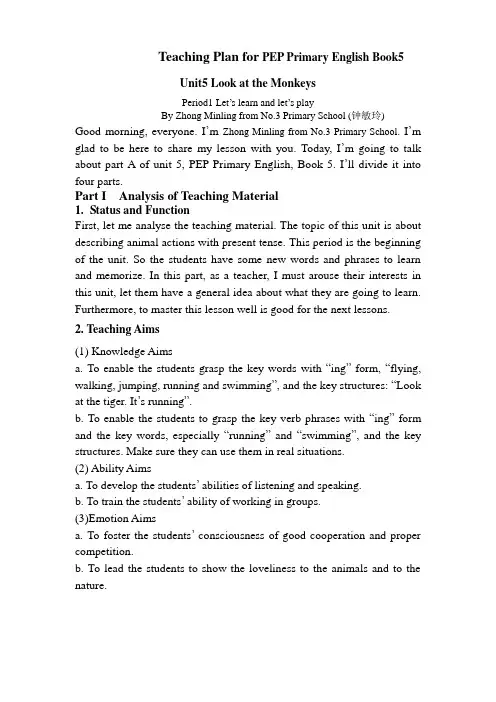
T eaching Plan for PEP Primary English Book5Unit5 Look at the MonkeysPeriod1 Let’s learn and let’s playBy Zhong Minling from No.3 Primary School (钟敏玲)Good morning, everyone. I’m Zhong Minling from No.3 Primary School. I’m glad to be here to share my lesson with you. Today, I’m going to talk about part A of unit 5, PEP Primary English, Book 5. I’ll divide it into four parts.Part I Analysis of Teaching Material1.Status and FunctionFirst, let me analyse the teaching material. The topic of this unit is about describing animal actions with present tense. This period is the beginning of the unit. So the students have some new words and phrases to learn and memorize. In this part, as a teacher, I must arouse their interests in this unit, let them have a general idea about what they are going to learn. Furthermore, to master this lesson well is good for the next lessons.2. T eaching Aims(1) Knowledge Aimsa. To enable the students grasp the key words with “ing” form, “flying, walking, jumping, running and swimming”, and the key structures: “Look at the tiger. It’s running”.b. To enable the students to grasp the key verb phrases with “ing” form and the key words, especially “running”and “swimming”, and the key structures. Make sure they can use them in real situations.(2) Ability Aimsa. To develop the students’ abilities of listening and speaking.b. To train the students’ ability of working in groups.(3)Emotion Aimsa. To foster the students’ consciousness of good cooperation and proper competition.b. To lead the students to show the loveliness to the animals and to the nature.3. T eaching important points and difficult pointsa. The important points: To help the students grasp the key words with “ing” form and the key structures. Make sure they can use them in real situations.b. The difficult points: To help the students grasp the key verb phrases with “ing” form, especially “running” and “swimming”. Make sure they can pronounce and write them correctly.Part II Teaching Methodsmunicative teaching method.2.Audio-visual teaching method.3.Task-based teaching method.As we all know, the main instructional aims of learning English in Primary School is to cultivate pupils’basic abilities of listening and speaking and their good sense of the English language. So in this lesson I’ll mainly use Communicative teaching method, Audio-visual teaching method and Task-based teaching method. That’s to say, I’ll let the students get a better understanding of the key words and structures. I’ll arrange several kinds of activities: singing, watching pictures, listening, guessing game, group work and so on. So in this lesson, a recorder, multi-media, cards and blackboard will be needed.Part III Studying Ways1.Let the students master the key verb phrases better by watching,listening, guessing and using.2.Enable the students study English language by communicating,describing and listening.3.Let the students understand how to compare qualities and how tocooperate.Part IV Teaching ProcedureStep 1 Warm-up1.Listen to the tape and sing the song “What are you doing?” together.2.Do some TPR. I’ll Show some cards of verb phrases and let thestudents read and do the actions.3.Free talk with the students: What are you doing?This step can arouse students’ interests of learning English by singing and doing some total physical response and at the same time it provides situations to review learned knowledge for the next step.Step 2 Presentation1.I’ll write down the words on the blackboard: fly, jump, walk. And letthe students do the actions. eg: Fly like a bird. Jump like a rabbit.Walk like an elephant.2.Show a bird picture and say: Look at the bird! What’s the bird doing?And lead the students to answer: It’s flying! The bird is flying. At the same time I’ll write down the word “flying” on the blackboard. Let the students read and repeat “flying, flying”.e the same method to teach “walking” and “jumping”.4.Point to the rabbit and ask: The rabbit is jumping, why? Lead to thestudents answer: Because the tiger is running. The tiger is running after the rabbit. Teach “running” and emphasis its form.5.Point to the fish in the water and ask: What is the fish doing? Lead thestudents to say: It’s swimming. And emphasis its form.6.Listen to the tape and get the students to follow it.This step I present the key words and structures one by one. It’s much easier for the students to learn and grasp the meanings. And tell the students we should show our loveliness to the animals and to the nature. Step 3 PracticeAfter dealing with the key verbs with “ing” form. I arrange three games. Game1. Test your eye sight. I show some flash animal pictures and get the students to say the action words. I’ll praise to do the best.Game2. Pair work. One student wears a headgear of an animal and does the action like the animal, the other student makes a sentence.Game3. Groups work. The first three students come to the blackboard. One takes out a card of an animal. The other takes out a card of word. Another reads out the sentence. If the sentence can do the movement of the animal, they keep the two cards, if not, put the cards back and continue the game.Though this step, students consolidate they learned in class and developtheir abilities of communication and cooperation.Step4 Homework1.Copy the words and sentences learned in class.2.Listen to the tape and read the words and sentences to your parents.It is necessary for the students to do some extensive exercises after class to consolidate the knowledge they learned.Blackboard designOn the top, there is the title of this lesson. On the left, there are some verbs. In the middle there are some verbs with “ing” form. On the right, there are some key sentences.That’s all for my teaching plan of this lesson. Thank you for your attention.。

Unit 5 Whose dog is it?A Let’s learn说课稿一、说教材分析本单元A 部分 Let’s learn 主要学习 hers,his,theirs,mine,yours, ours 等名词性物主代词及 Whose dog is it? It’s her dog./The dog is hers.等句型,并运用这些名词性物主代词来描述自己的物品。
采用丰富的教学活动,不断的巩固所学新知,通过游戏练习名词性物主代词,来加深学生的印象。
让学生把所学知识运用到实际生活中,培养了学生学习的积极性。
二、说学情分析五年级的学生具有活泼好动,爱表现自己的年龄特征,他们已经学习了两年多的英语,掌握了基本的口语交际能力,同学之间能够进行简单的会话。
本课充分利用贴近学生生活中的物品,激发学生的学习兴趣,让他们在所创设的情境中能够更好地融入到课堂教学中,从而达到学以致用的效果。
三、说令公桃李满天下,何用堂前更种花。
出自白居易的《奉和令公绿野堂种花》四、◆教学目标结合新课程标准及英语课程的总体目标我将令公桃李满天下,何用堂前更种花。
出自白居易的《奉和令公绿野堂种花》◆教学目标及重难点设计如下:令公桃李满天下,何用堂前更种花。
出自白居易的《奉和令公绿野堂种花》◆教学目标知识与技能:掌握 hers,his,theirs,mine,yours,ours 等名词性物主代词及 Whose dog is it?It’s her dog.-The dog is hers.等句型,并运用这些名词性物主代词来描述自己的物品。
过程与方法:热身活动导入,游戏活跃气氛,通过小组合作,练习学生的说的能力。
情感态度与价值观:教育学生养成保管好自己物品的良好习惯。
五、教学重点、重点:掌握 hers,his,theirs,mine,yours,ours 等名词性物主代词及 Whose dog is it?It’ s her dog.-The dog is hers.等句型,并运用这些名词性物主代词来描述自己的物品。
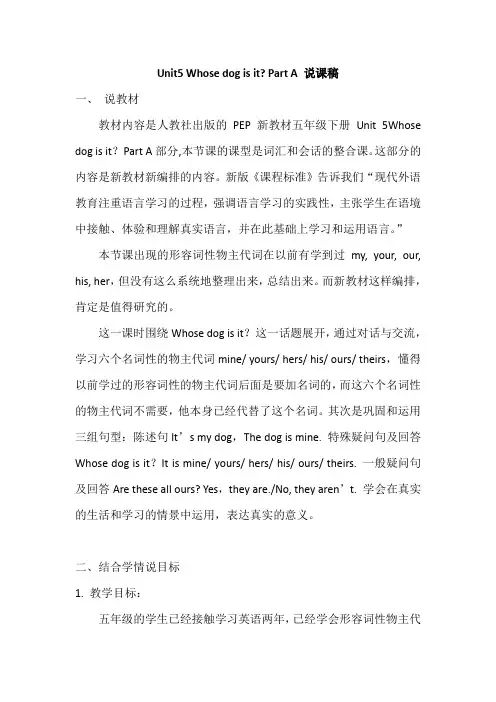
Unit5 Whose dog is it? Part A 说课稿一、说教材教材内容是人教社出版的PEP新教材五年级下册Unit 5Whose dog is it?Part A部分,本节课的课型是词汇和会话的整合课。
这部分的内容是新教材新编排的内容。
新版《课程标准》告诉我们“现代外语教育注重语言学习的过程,强调语言学习的实践性,主张学生在语境中接触、体验和理解真实语言,并在此基础上学习和运用语言。
”本节课出现的形容词性物主代词在以前有学到过my, your, our, his, her,但没有这么系统地整理出来,总结出来。
而新教材这样编排,肯定是值得研究的。
这一课时围绕Whose dog is it?这一话题展开,通过对话与交流,学习六个名词性的物主代词mine/ yours/ hers/ his/ ours/ theirs,懂得以前学过的形容词性的物主代词后面是要加名词的,而这六个名词性的物主代词不需要,他本身已经代替了这个名词。
其次是巩固和运用三组句型:陈述句It’s my dog,The dog is mine. 特殊疑问句及回答Whose dog is it?It is mine/ yours/ hers/ his/ ours/ theirs. 一般疑问句及回答Are these all ours? Yes,they are./No, they aren’t. 学会在真实的生活和学习的情景中运用,表达真实的意义。
二、结合学情说目标1. 教学目标:五年级的学生已经接触学习英语两年,已经学会形容词性物主代词my/your/her/his/our/their,名词性的物主代词是今天要学的内容,所以根据学生的学习情况,我制定了如下教学目标:(1)知识目标:能够学会并运用六个物主代词,能够使用句型It’s my dog,The dog is mine. Whose dog is it?It is mine/ yours/ hers/ his/ ours/ theirs. 询问Are these all ours? Yes,they are./No, they aren’t.对自己和他人的东西进行介绍,询问调查。
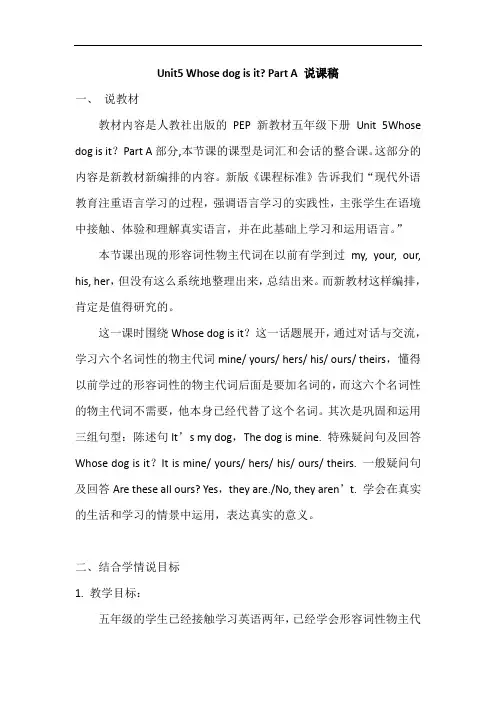
Unit5 Whose dog is it? Part A 说课稿一、说教材教材内容是人教社出版的PEP新教材五年级下册Unit 5Whose dog is it?Part A部分,本节课的课型是词汇和会话的整合课。
这部分的内容是新教材新编排的内容。
新版《课程标准》告诉我们“现代外语教育注重语言学习的过程,强调语言学习的实践性,主张学生在语境中接触、体验和理解真实语言,并在此基础上学习和运用语言。
”本节课出现的形容词性物主代词在以前有学到过my, your, our, his, her,但没有这么系统地整理出来,总结出来。
而新教材这样编排,肯定是值得研究的。
这一课时围绕Whose dog is it?这一话题展开,通过对话与交流,学习六个名词性的物主代词mine/ yours/ hers/ his/ ours/ theirs,懂得以前学过的形容词性的物主代词后面是要加名词的,而这六个名词性的物主代词不需要,他本身已经代替了这个名词。
其次是巩固和运用三组句型:陈述句It’s my dog,The dog is mine. 特殊疑问句及回答Whose dog is it?It is mine/ yours/ hers/ his/ ours/ theirs. 一般疑问句及回答Are these all ours? Yes,they are./No, they aren’t. 学会在真实的生活和学习的情景中运用,表达真实的意义。
二、结合学情说目标1. 教学目标:五年级的学生已经接触学习英语两年,已经学会形容词性物主代词my/your/her/his/our/their,名词性的物主代词是今天要学的内容,所以根据学生的学习情况,我制定了如下教学目标:(1)知识目标:能够学会并运用六个物主代词,能够使用句型It’s my dog,The dog is mine. Whose dog is it?It is mine/ yours/ hers/ his/ ours/ theirs. 询问Are these all ours? Yes,they are./No, they aren’t.对自己和他人的东西进行介绍,询问调查。

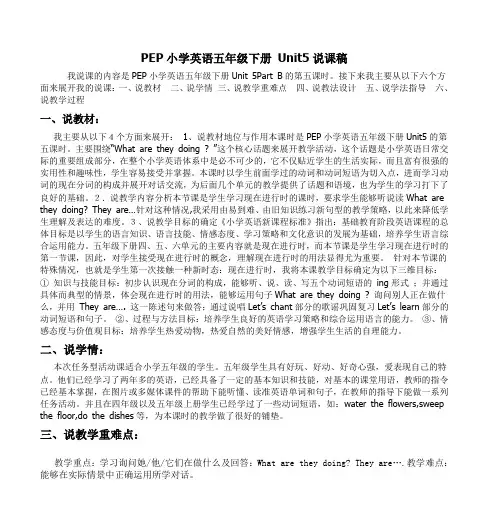
PEP小学英语五年级下册Unit5说课稿我说课的内容是PEP小学英语五年级下册Unit 5Part B的第五课时。
接下来我主要从以下六个方面来展开我的说课:一、说教材二、说学情三、说教学重难点四、说教法设计五、说学法指导六、说教学过程一、说教材:我主要从以下4个方面来展开:1、说教材地位与作用本课时是PEP小学英语五年级下册Unit5的第五课时。
主要围绕“What are they doing ? ”这个核心话题来展开教学活动,这个话题是小学英语日常交际的重要组成部分,在整个小学英语体系中是必不可少的,它不仅贴近学生的生活实际,而且富有很强的实用性和趣味性,学生容易接受并掌握。
本课时以学生前面学过的动词和动词短语为切入点,进而学习动词的现在分词的构成并展开对话交流,为后面几个单元的教学提供了话题和语境,也为学生的学习打下了良好的基础。
2.说教学内容分析本节课是学生学习现在进行时的课时,要求学生能够听说读What are they doing? They are…针对这种情况,我采用由易到难、由旧知识练习新句型的教学策略,以此来降低学生理解及表达的难度。
3、说教学目标的确定《小学英语新课程标准》指出:基础教育阶段英语课程的总体目标是以学生的语言知识、语言技能、情感态度、学习策略和文化意识的发展为基础,培养学生语言综合运用能力。
五年级下册四、五、六单元的主要内容就是现在进行时,而本节课是学生学习现在进行时的第一节课,因此,对学生接受现在进行时的概念,理解现在进行时的用法显得尤为重要。
针对本节课的特殊情况,也就是学生第一次接触一种新时态:现在进行时,我将本课教学目标确定为以下三维目标:①知识与技能目标:初步认识现在分词的构成,能够听、说、读、写五个动词短语的ing形式;并通过具体而典型的情景,体会现在进行时的用法,能够运用句子What are they doing ? 询问别人正在做什么,并用They are…. 这一陈述句来做答;通过说唱Let’s chant部分的歌谣巩固复习Let’s learn部分的动词短语和句子。

Unit 5 Whose dog is it? Part B Let’s try&Let’s talk说课稿Good morning,everyone. I’m so great honor and pleasure to stand here and share my lesson with you. I’m going to talk about PEP Book 6 Unit 5 Part B Let’s try and Let’s talk. If learning is like a voyage on the sea, students are boats and the teaching material should be this beautiful sea. only by raising the sail of teaching strategies, relying on the teaching objects lighthouse guidance, the boat can ride the wind and waves, sailing to the other side of the ideal. Please join me on this voyage.Teaching material, Students, Teaching Objects, ,Teaching Strategies , and Teaching procedures.一、说教材(teaching material)The begin with, I will talk about Teaching Material.This lesson is Part B of Unit 5, it includes two parts: Let’s try and Let’s talk. “Sam is at Chen Jie’s home. They are talking about Fido, Chen Jie’s pet. The key words are: eating, drinking water, sleeping, take...to, and play ...with. The key sentences of this dialogues are” Where is Fido?” “ Is he eating?”And the answers. Help the students understand the present continuous tense in a real situation.二、说学生Students Besides the material, students are the most important part ofa lesson.The students are in Grade 5. They have learned English for about 3 years so far. They have taken more and more interests in English. 1.They are active to share their ideas to each other. 2, They are able to discuss and work in pairs and groups. 3. And they are interested in real and familiar topics. This Unit is about animals. This is an interesting topic for children. So it’s not difficult for them to learn this lesson.三、教学目标(Teaching Objects)The Core competences of English includes 4 dimensions: Language Ability, Thinking Quality, Learning Ability, and Cultural Awareness.According to these, and after studying the teaching material and the facts of the Students, I set up the teaching objective for E words:Enable students to understand , read and role-play the dialogue.Empower students to use the key words and sentences properly.Enhance students abilities of listing, speaking and working in pairs or groups.Enrich students’ understanding about being friendly to animals.四、说教学策略Teaching StrategiesNext, I am talking about Teaching Strategies. It include : Teaching methods and learning methods.1.说教法(teaching methods)In this lesson, I will mainly use “Situational teaching method”and “Task-based teaching method” . Let the Students learn in real situations and in activities. In this lesson,PPT, blackboard and cards will be used.2.说学法(Learning methods)As a teacher , I know “teaching students to fish is better than giving them fish”. So it is more important to Teach the students how to be good language learners.Let the students pass “Observation—Imitation—Practice”to study language.Teach the students how to master dialogues and how to communicate with others.五、教学过程(teaching procedures)Now, we come to the most important part ----Teaching Procedures. I will finish the lesson in4steps.Step 1. Warming-upAfter greeting with the Students, I will begin the lesson by singing the song“walking”and do the actions together with the Students. There are some present participles of the verbs like “walking, sleeping, running ,swimming.”in the song. Then ask “What animals can you see in the video?” Tiger , rabbit, pig ...Purpose(目的意图):To train children’s memory.1.Singing can draw students' attention arouse their interest.and alsolead them to the topic---animals.Step 2. Presentation(1)新授单词和句型Ask Students Do you like animals ? I like animals ,too . With the help of the PPT, I’ll show my pet . Let Students guess,”What’s it?” Maybe a dog? A rabbit? .. It’s a lovely cat. Next I’ll show a picture, “What is he doing?” and help Students say” He is eating .” Then show another picture “Is he eating?” Help them answer,” No, he isn’t. He is drinking. Teach “sleep” as the same way. Help them find and summarize: be ad the present participle of verb show someone is doing something. Then make a chant to practice the new words and sentences. like“doing,doing , what he doing? Eating , eating , he is eating. ...Purpose(目的意图):Using these lovely pictures To rise students learning interest.Help Ss To master new words and sentence patterns in a true situation.Chant can help the Students learn the language easily and naturally.(2)Let’s tryTell Students Chen Jie has a pet too. It’s name is Fido. First , talk about the 3 pictures of this part with Students. “Where is Fido? And What’s he doing”. Play the cassette and do listing exercise. Then check the answer. Then Listen again . “Sam wants to take Fido to the park. But, he can’t. Why? Help Students answer,”Because Fido is sleep.”A moment later, someone is knocking at the door. Guess, who is coming ? Look , It’s Sam.Purpose(目的意图):Through listening test to develop the students listening ability and understanding ability . And it is naturally to lead Ss to learn the nextpart“Let’s talk”.(3)Let’s talkIn this part,I will have some task for the students. First, let the listen to the dialogue. Answer the question”Is Fido sleeping now?”, Students and give the answer quickly.”No, it isn’t.” Then I’ll give them 3 more questions. After watching the video of the text, Students talk with their partner.” Where is Fido now? He’s in the kitchen.What is Fido doing?He’s eating.Can Sam take Fido to the park?Yes, he can.Purpose(目的意图):These tasks help the students understand the dialogue. Solve the meaning of the new words “take ...to”, to train the Students ability to understand the words in the dialogue.After that, Students watch the video and repeat.Pay attention to the pronunciation and intonation.Step 3. Practice1.I will practice the students with a new training method,Dubbing.By using the video, Students dub for Sam, then dub for Chen Jie.Purpose(目的意图):I think dubbing is a new and interesting way to practise the dialogue with correct pronunciation and intonation.2.Work in groups.4Ss in a group. Then have a dubbing show. One student act Fido. So that, Students feel that Fido is a member of the family. Purpose(目的意图):this task can Develop Ss’ ability of cooperation.Step 4. DevelopmentShow the pictures, Where is Fido now? He is in the park. Sam takes Fido to the Park. They are playing in the park.A moment later, Chen Jie is calling Sam. She missed Fido. Listen to the dialogue. Then Students work in pairs. After a few minutes, Students show their dialogue.Purpose(目的意图):To get the structure ready for Ss output.To provide chance to practice target language. Help SS to learn how to communicate with others.Step 5. Show some warm pictures. And say: Animals are our friends, in many People’s eyes, pets are their family members and they are used to describe them with "he" or "she".Purpose(目的意图):Enrich students’understanding about being friendly to animals.Step 6.Homework As for homework, Students need to read and role-play the dialogue. And make the sentences by using the key words and sentences.Purpose(目的意图):1.to consolidate what they have learned in the class. 1.to meet needs of different studentsThe journey of teaching. I am the captain of the teaching journey. Text and students are my helpful buddies. Objectives and activities are my guiding stars. Let’s set off with joyful hearts.。


PEP小学英语五年级下册Unit5说课稿我说课的内容是PEP小学英语五年级下册Unit 5Part B的第五课时。
接下来我主要从以下六个方面来展开我的说课:一、说教材二、说学情三、说教学重难点四、说教法设计五、说学法指导六、说教学过程一、说教材:我主要从以下4个方面来展开:1、说教材地位与作用本课时是PEP小学英语五年级下册Unit5的第五课时。
主要围绕“What are they doing ? ”这个核心话题来展开教学活动,这个话题是小学英语日常交际的重要组成部分,在整个小学英语体系中是必不可少的,它不仅贴近学生的生活实际,而且富有很强的实用性和趣味性,学生容易接受并掌握。
本课时以学生前面学过的动词和动词短语为切入点,进而学习动词的现在分词的构成并展开对话交流,为后面几个单元的教学提供了话题和语境,也为学生的学习打下了良好的基础。
2.说教学内容分析本节课是学生学习现在进行时的课时,要求学生能够听说读What are they doing? They are…针对这种情况,我采用由易到难、由旧知识练习新句型的教学策略,以此来降低学生理解及表达的难度。
3、说教学目标的确定《小学英语新课程标准》指出:基础教育阶段英语课程的总体目标是以学生的语言知识、语言技能、情感态度、学习策略和文化意识的发展为基础,培养学生语言综合运用能力。
五年级下册四、五、六单元的主要内容就是现在进行时,而本节课是学生学习现在进行时的第一节课,因此,对学生接受现在进行时的概念,理解现在进行时的用法显得尤为重要。
针对本节课的特殊情况,也就是学生第一次接触一种新时态:现在进行时,我将本课教学目标确定为以下三维目标:①知识与技能目标:初步认识现在分词的构成,能够听、说、读、写五个动词短语的ing形式;并通过具体而典型的情景,体会现在进行时的用法,能够运用句子What are they doing ? 询问别人正在做什么,并用They are…. 这一陈述句来做答;通过说唱Let’s chant部分的歌谣巩固复习Let’s learn 部分的动词短语和句子。
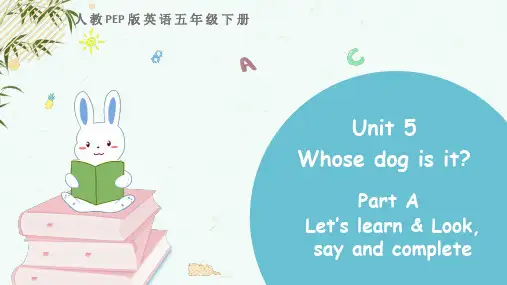

Unit5 Whose dog is it? Part A 说课稿一、说教材教材内容是人教社出版的PEP新教材五年级下册Unit 5Whose dog is it?Part A局部,本节课的课型是词汇和会话的整合课。
这局部的内容是新教材新编排的内容。
新版《课程标准》告诉我们“现代外语教育注重语言学习的过程,强调语言学习的实践性,主张学生在语境中接触、体验和理解真实语言,并在此根底上学习和运用语言。
〞本节课出现的形容词性物主代词在以前有学到过my, your, our, his, her,但没有这么系统地整理出来,总结出来。
而新教材这样编排,肯定是值得研究的。
这一课时围绕Whose dog is it?这一话题展开,通过对话与交流,学习六个名词性的物主代词mine/ yours/ hers/ his/ ours/ theirs,懂得以前学过的形容词性的物主代词后面是要加名词的,而这六个名词性的物主代词不需要,他本身已经代替了这个名词。
其次是稳固和运用三组句型:陈述句It’s my dog,The dog is mine. 特殊疑问句及答复Whose dog is it?It is mine/ yours/ hers/ his/ ours/ theirs. 一般疑问句及答复Are these all ours? Yes,they are./No, they aren’t. 学会在真实的生活和学习的情景中运用,表达真实的意义。
二、结合学情说目标1. 教学目标:五年级的学生已经接触学习英语两年,已经学会形容词性物主代词my/your/her/his/our/their,名词性的物主代词是今天要学的内容,所以根据学生的学习情况,我制定了如下教学目标:〔1〕知识目标:能够学会并运用六个物主代词,能够使用句型It’s my dog,The dog is mine. Whose dog is it?It is mine/ yours/ hers/ his/ ours/ theirs. 询问Are these all ours? Yes,they are./No, they aren’t.对自己和他人的东西进行介绍,询问调查。